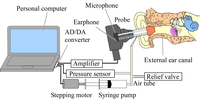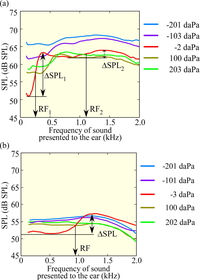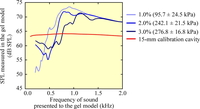Dynamic behavior of the auditory system in neonates

Fig. 1. Schema of the SFI meter for testing neonates. The SFI meter consists of a personal computer, an AD/DA converter, a probe system (*1), a stepping motor, a syringe pump, a pressure sensor and a relief valve. This new SFI meter is controlled using LabView.

Fig. 2. Representative SFI results. (a) Healthy neonate. (b) Normal hearing adult. When the static pressure applied to the external ear canal was near ambient pressure (about 0 daPa), two variations in the sound pressure were observed at around 0.3 kHz and 1.2 kHz in neonates while such variation was observed at around 1.4 kHz in adults.

Fig. 3. Representative SFI results obtained from three types of gel models with different mass percentage of the agarose. The mass percentages were 1.0%, 2.0% and 3.0%. Results showed a variation in SPL at around 0.5 kHz as in the case of neonates.
The middle ear, which consists of the tympanic membrane and the ossicular chain, etc., transmits the sound to the cochlea in the inner ear. Thus, the middle ear dysfunction causes the conductive hearing loss. Early diagnosis and treatment of such disorders in neonates is highly effective for realization of linguistic competence and intellectual development. The sweep frequency impedance (SFI) meter, developed to measure the dynamic characteristics of the middle ear (Wada et al., 1989), has been successfully used to detect middle ear problems in adults and children (Wada et al., 1998). However, its application to neonates has never been explored.
In the present study, therefore, the SFI meter was improved, i.e., the diameter of the probe was reduced to that of the neonatal external ear canal. By using this newly designed SFI meter, SFI tests were performed in healthy neonates and gel models, which mimics the neonatal external ear canal.
The sound pressure level (SPL) showed two variations at 0.3 kHz and 1.2 kHz (Fig. 2(a)). Since the SPL is known to show a variation at frequencies around 1.4 kHz due to the resonance of the middle ear in adults and children with normal hearing (Fig. 2(b)), the second variation is probably related to such resonance in neonates.
The measurement of the gel models showed a variation in SPL at around 0.5 kHz (Fig. 3). This implies that the source of the first variation may possibly be related to the resonance of the external ear canal wall. This result suggests that the dynamic characteristics of the middle ear in neonates are different from those in adults.
This study was approved by the Ethics Committees on Clinical Investigation of Tohoku University School of Medicine and the Japanese Red Cross Sendai Hospital and was performed in accordance with the policy of the Declaration of Helsinki.
This study is conducted in collaboration with Professor Hiroshi Wada (Emeritus Professor of Tohoku University and Tohoku Bunka Gakuen University, Sendai, Japan), Associate Professor Shinji Hamanishi (Tohoku Gakuin University, Sendai, Japan) and Associate Professor Joseph Kei (The University of Queensland, Brisbane, Australia).
(*1) An example of input sound from the SFI meter to the external ear canal.
- Kanka N, Murakoshi M, Hamanishi S, Kakuta R, Matsutani S, Kobayashi T, Wada H. Longitudinal changes in dynamic characteristics of neonatal external and middle ears. Int J Pediat Otorhinolaryngol 134:110061, 2020.
- Aithal V, Kei J, Driscoll C, Murakoshi M, Wada H. Predictive accuracy of sweep frequency impedance technology in identifying conductive conditions in newborns. J Am Acad Audiol 29:106-117, 2018.
- Murakoshi M, Sano K, Kanka N, Yoshida N, Hamanishi S, Kiyokawa H, Kakuta R, Aithal S, Aithal V, Kei J, Driscoll C, Swanston A, Matsutani S, Kobayashi T, Wada H. Analysis by sweep frequency impedance (SFI) meter of 226-Hz and 1,000-Hz tympanometries in neonates. Procedia IUTAM 24:5-14, 2017.
- Murakoshi M, Takeda S, Wada H. Analysis by finite element method of dynamic characteristics of the external ear canal in neonates. J Biomech Sci Eng 12:16-00596, 2017.
- Aithal V, Kei J, Driscoll C, Murakoshi M, Wada H. Sweep frequency impedance measures in young infants: developmental characteristics from birth to 6 months. Int J Audiol 56:154-163, 2017.
- Aithal V, Kei J, Driscoll C, Murakoshi M, Wada H. Effects of ear canal static pressure on the dynamic behaviour of outer and middle ear in newborns. Int J Pediatr Otorhinolaryngol 82:64-72, 2016.
- Aithal V, Kei J, Driscoll C, Swanston A, Roberts K, Murakoshi M, Wada H. Sweep frequency impedance measures in Australian aboriginal and Caucasian neonates. Int J Pediatr Otorhinolaryngol 79: 1024-1029, 2015.
- Aithal V, Kei J, Driscoll C, Swanston A, Roberts K, Murakoshi M, Wada H. Normative sweep frequency impedance measures in healthy neonates. J Am Acad Audiol 25: 343-354, 2014.
- Murakoshi M, Yoshida N, Sugaya M, Ogawa Y, Hamanishi S, Kiyokawa H, Kakuta R, Yamada M, Takahashi R, Tanigawara S, Matsutani S, Kobayashi T, Wada H. Dynamic characteristics of the middle ear in neonates. Int J Pediatr Otorhinolaryngol 77: 504-512, 2013.